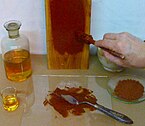Drying oil
| Plant oils |
|---|
 |
| Types |
|
| Uses |
| Components |
A drying oil is an
Since oxidation is the key to curing in these oils, those that are susceptible to chemical drying are often unsuitable for cooking, and are also highly susceptible to becoming rancid through autoxidation, the process by which fatty foods develop off-flavors.[1] Rags, cloth, and paper saturated with drying oils may spontaneously combust (ignite) after a few hours as heat is released during the oxidation process.
Chemistry of the drying process
The "drying", hardening, or, more properly,

Simplified chemical reactions associated with cobalt-catalyzed drying process. In the first step, the diene undergoes autoxidation to give a hydroperoxide. In the second step, the hydroperoxide combines with another unsaturated side chain to generate a crosslink.
The early stages of the drying process can be monitored by weight changes in an oil film. The film becomes heavier as it absorbs oxygen.
Most drying oils rapidly increase in viscosity after heating in the absence of air. If the oil is subjected to raised temperatures for a long time, it will become a rubbery oil-insoluble substance.[3]
Role of metal catalysts
The drying process is accelerated by certain metal salts, especially derivatives of
Constituents
- alpha-linolenic (middle), and oleic acids(bottom). The order of drying rate is alpha-linolenic > linoleic > oleic acid, reflecting their degree of unsaturation.
Drying oils consist of
Comparison to waxes and resins
Non-"drying"
Safety
Rags, cloth, and paper saturated with drying oils may combust spontaneously (ignite) due to heat released during the curing process. This hazard is greater when oil-soaked materials are folded, bunched, or piled together, which allows heat to accumulate and accelerate the reaction. Precautions include: wetting rags with water and spreading them away from direct sunlight; keeping them in air-tight fireproof metal containers; immersing them in water inside air-tight metal containers designed for such applications; or storing them immersed in solvents in suitable closed containers.[citation needed]
Leaving linseed-oil-soaked rags in a pile after refinishing woodwork was the cause of a 1991 fire in Philadelphia's One Meridian Plaza, a 38-story office building, which resulted in severe structural damage, and eventually the demolition of the building.
See also
References
- ISBN 978-3527306732.
- ^ a b Apps, E. A. (1958). Printing Ink Technology. London: Leonard Hill [Books] Limited. p. 14.
Further reading
- "Autoxidation". McGraw Hill Encyclopedia. 8th ed. 1997.
- Friedman, Ann, et al. "Painting". www.worldbookonline.com. 2006. 46 Stetson St. #5 Brookline, MA. 10 May 2006
- "History of Oil Paint". www.cyberlipid.org. 5 May 2006 (archived 16 September 2009).
- van den Berg, Jorit D.J. "Mobile and Stationary Phases in Traditional Aged Oil Paint". www.amolf.nl 2002. MOLART. 8 May 2006
- Andés, Louis Edgar, Drying oils, boiled oil, and solid and liquid driers. London: Scott, Greenwood & Co., 1901.
External links
- Tung and Linseed Oils by Steven D. Russel

